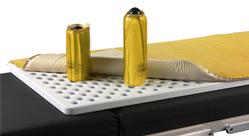
Some surgical procedures require extreme positioning to ensure that the targeted surgical area is accessible to the surgeon and the surgical team. Extreme positioning requires extreme positioning devices which are manufactured to meet the need for surgical access first and foremost. Unfortunately, the devices and positions needed for optimal surgical access can increase the risk for an interoperative medical device related pressure injury. The resultant pressure injury generally mirrors the pattern or shape of the device. One common position that fits the extreme high-risk description is the Lateral Decubitus Position. This position is commonly used during surgery requiring access to the thorax, retroperitoneum, or hip with a patient lying on the nonoperative side and careful positioning of the extremities. The following are some best practices to help when positioning the patient in a lateral position.
- The lower extremities are carefully padded between the knees and below the dependent knee to avoid excessive external pressure over bony prominences. The dependent lower extremity is somewhat flexed to avoid stretch or compression of the lower extremity nerves.
- Upper extremities are placed in front of the patient with neither arm abducted more than 90 degrees to prevent brachial plexus injury; an axillary roll should be placed below the axilla to prevent compression of the brachial plexus and axillary vascular structures.
- The dependent upper extremity is flexed at the shoulder and slightly flexed at the elbow and secured on a padded arm board with padding under bony prominences; invasive arterial monitoring should be placed in the dependent arm to better detect compression of the axillary vascular structures.
- The non-dependent upper extremity is flexed at the shoulder and slightly flexed at the elbow and often secured with a suspended armrest with care not to abduct the arm more than 90 degrees and to pad the bony prominences.
- The head and neck are maintained in a neutral position to prevent lateral rotation and stretch injury to the brachial plexus; care must be given to avoid folding or rolling the dependent ear or undue external pressure on the dependent eye.
Now that we have discussed positioning the patient safely in the lateral decubitus position, let’s talk about lateral positioning devices and the risk they bring to Medical Device related pressure injuries. Medical device-related pressure injuries result from use of medical devices, equipment, furniture, and everyday objects in direct contact with skin and increased external mechanical load, leading to soft tissue damage. There are different types of positioning devices for the lateral position, each are structurally different and are used differently based on the surgical need. Let’s look at lateral hip surgery.
One of the fundamental functions of the lateral hip surgical positioning device is to rigidly secure patients into the position throughout surgery. The Peg Board is often used for lateral hip surgery, the pegboard comes with numerous holes for the pegs. Therefore, a surgeon can select which holes match the size of the patient. The surgical pegs come in different sizes for versatility, moreover, the pegs lock into and fit perfectly with the surgical pegboards to prevent any motion during operation. When using the peg board or any other rigid positioning device the risk for medical device pressure injury increases because of tissue compression that restricts blood flow and disrupts cellular integrity.
Pressure injury risk mitigation takes preplanning and critical thinking, when using the peg board, it is not only important to protect the bony prominence, but it is as important to cover the device and pegs themselves to decrease the medical device pressure on the patient. A great solution to the harsh pegboard is, The Action® Overlay and Post Pad Set . It helps to protect skin integrity in the high-pressure lateral position, by reducing pressure on fragile bony prominences. The post pads have a hook and loop attachment to universally fit your morph or peg board sets.

Planning for the high-risk position and implementing evidence-based interventions can protect your patients from medical device pressure injuries and provide them with the outcome that they deserve.
Crit Care Nurs Clin North Am. 2020 Dec;32(4):533-542.doi: 10.1016/j.cnc.2020.08.004. Epub 2020 Oct 7.
Medical Device-Related Pressure Injuries
Anatomy, Patient Positioning https://www.ncbi.nlm.nih.gov/books/NBK513320/
Maggie Armstrong; Ross A. Moore.
B9011-000

